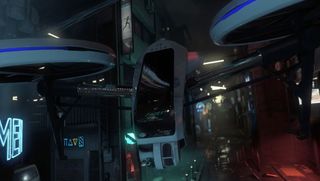This free benchmark wants to evaluate your PC's ray tracing capabilities
It works with both AMD and Nvidia GPUs.

What started off as a tech demo from Crytek is now a benchmark to test how well (or not so well) your PC handles ray-traced content. It's called Neon Noir, and it is available to download for free from the CryEngine Marketplace.
You'll need to jump through some hoops to get it. Specifically, you need to register an account, activate your account (via an emailed link), download and install the launcher, add the game to your cart on the web, and finally download the 4.4GB installation package (through the launcher).
The minimum specs are not super demanding for a ray-traced workload, though you will need a moderately powerful PC. Here's what Crytek recommends:
- AMD Ryzen 5 2500X or Intel Core i7-8700
- AMD Vega 56 (8GB) or Nvidia GeForce GTX 1070 (8GB)
- 16GB RAM
- Windows 10 64-bit
- DirectX 11
You have the option of setting the level of ray tracing to Very High or Ultra. The latter is more demanding, with ray traced reflections rendered at the same resolution as the scene. If dropping down to Very High, the benchmark will "adjust a value called LowSpecMode to reduce the resolution of those reflections for rigs with lower performance, saving rendering costs, while still delivering a beautiful scene."
There is also the option of changing the screen resolution. To give an example of the Very High setting, at 1920x1080, ray-traced reflections get rendered at "approximately" 1357x763.
What's neat about this benchmark is it works with both AMD and Nvidia GPUs.
"CryEngine's ray tracing technology is both hardware and API agnostic and will run on most mainstream contemporary AMD and Nvidia GPUs, whereas other ray tracing methods are typically bound to GPU solutions with dedicated RT cores. The feature will ship in CryEngine in 2020, optimized to take advantage of performance enhancements delivered by the latest generation of graphics cards from all manufacturers and supported APIs like Vulkan and DX12," Crytek says.
The biggest gaming news, reviews and hardware deals
Keep up to date with the most important stories and the best deals, as picked by the PC Gamer team.
As Black Friday deals roll into view, you might be tempted to pick up a GeForce RTX card with dedicated RT cores, and we'll certainly be on the lookout for good bargains. However, Crytek suggests dedicated ray tracing hardware will not necessarily be required, if developers utilize CryEngine's ray tracing technology next year. We'll have to wait and see.
I don't have much context for evaluating benchmark scores, but I did run this on my daily workhorse with a Core i7-4790K CPU, 32GB of RAM, 1TB (2x512GB) SSD in RAID 0, and a GeForce GTX 1080 Ti GPU. I stuck to the default settings (1600x900 windowed at Ultra) and scored 10,659. That's with a bunch of applications opened in the background, too.
It's a promising benchmark. During my run, I stayed above 100 fps almost the entire time (sometimes it climbed to around 140 fps), save for a brief dip to 97 fps. I was not expecting that. Technically, Nvidia's latest drivers enable real-time ray tracing support on Turing and Pascal generation GeForce GTX cards, but in our experience, an RTX card is really needed for games that support ray tracing. At least for now, anyway.
Paul has been playing PC games and raking his knuckles on computer hardware since the Commodore 64. He does not have any tattoos, but thinks it would be cool to get one that reads LOAD"*",8,1. In his off time, he rides motorcycles and wrestles alligators (only one of those is true).
Most Popular






